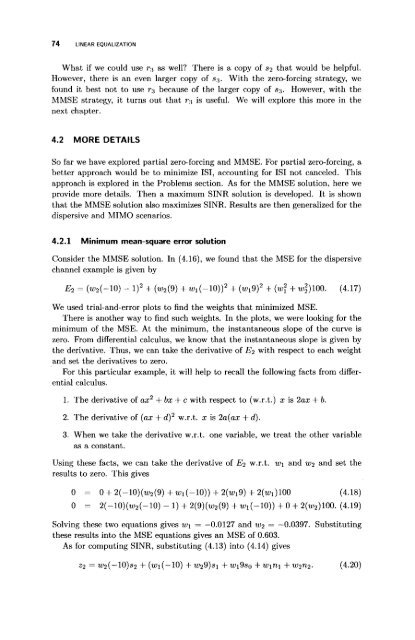mohatta2015.pdf
signal processing from power amplifier operation control point of view
signal processing from power amplifier operation control point of view
You also want an ePaper? Increase the reach of your titles
YUMPU automatically turns print PDFs into web optimized ePapers that Google loves.
74 LINEAR EQUALIZATION<br />
What if we could use r-.ι, as well? There is a copy of s 2 that would be helpful.<br />
However, there is an even larger copy of s,¡. With the zero-forcing strategy, we<br />
found it best not to use r,-¡ because of the larger copy of s;j. However, with the<br />
MMSE strategy, it turns out that r :i is useful. We will explore this more in the<br />
next chapter.<br />
4.2 MORE DETAILS<br />
So far we have explored partial zero-forcing and MMSE. For partial zero-forcing, a<br />
better approach would be to minimize ISI, accounting for ISI not canceled. This<br />
approach is explored in the Problems section. As for the MMSE solution, here we<br />
provide more details. Then a maximum SINR solution is developed. It is shown<br />
that the MMSE solution also maximizes SINR. Results are then generalized for the<br />
dispersive and MIMO scenarios.<br />
4.2.1 Minimum mean-square error solution<br />
Consider the MMSE solution. In (4.16), we found that the MSE for the dispersive<br />
channel example is given by<br />
E 2 = (w 2 (-10) - l) 2 + (w 2 (9) + wi(-10)) 2 + ( Wl 9) 2 + {w\ + w|)100. (4.17)<br />
We used trial-and-error plots to find the weights that minimized MSE.<br />
There is another way to find such weights. In the plots, we were looking for the<br />
minimum of the MSE. At the minimum, the instantaneous slope of the curve is<br />
zero. From differential calculus, we know that the instantaneous slope is given by<br />
the derivative. Thus, we can take the derivative of E 2 with respect to each weight<br />
and set the derivatives to zero.<br />
For this particular example, it will help to recall the following facts from differential<br />
calculus.<br />
1. The derivative of ax 2 + bx + c with respect to (w.r.t.) x is 2ax + b.<br />
2. The derivative of (ax + d) 2 w.r.t. x is 2a(ax + d).<br />
3. When we take the derivative w.r.t. one variable, we treat the other variable<br />
as a constant.<br />
Using these facts, we can take the derivative of E 2 w.r.t. w\ and ω 2 and set the<br />
results to zero. This gives<br />
0 = 0 + 2(-10)(u) 2 (9)+wi(-10)) + 2(u> 1 9)+2(w 1 )100 (4.18)<br />
0 = 2(-10)(w 2 (-10) - 1) + 2(9)(w 2 (9) + wi(-10)) + 0 + 2(w 2 )100. (4.19)<br />
Solving these two equations gives w\ = —0.0127 and w 2 = —0.0397. Substituting<br />
these results into the MSE equations gives an MSE of 0.603.<br />
As for computing SINR, substituting (4.13) into (4.14) gives<br />
2 2 = W 2 (-10)S2 + (Wl(—10) + W 2 9)si + Wl9S() + Wim + W2H2- (4.20)



